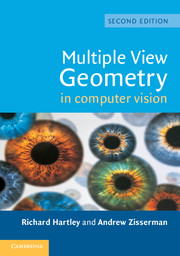Book contents
- Frontmatter
- Contents
- Foreword
- Preface
- 1 Introduction – a Tour of Multiple View Geometry
- PART 0 The Background: Projective Geometry, Transformations and Estimation
- 2 Projective Geometry and Transformations of 2D
- 3 Projective Geometry and Transformations of 3D
- 4 Estimation – 2D Projective Transformations
- 5 Algorithm Evaluation and Error Analysis
- PART I Camera Geometry and Single View Geometry
- PART II Two-View Geometry
- PART III Three-View Geometry
- PART IV N-View Geometry
- PART V Appendices
- Bibliography
- Index
2 - Projective Geometry and Transformations of 2D
Published online by Cambridge University Press: 25 January 2011
- Frontmatter
- Contents
- Foreword
- Preface
- 1 Introduction – a Tour of Multiple View Geometry
- PART 0 The Background: Projective Geometry, Transformations and Estimation
- 2 Projective Geometry and Transformations of 2D
- 3 Projective Geometry and Transformations of 3D
- 4 Estimation – 2D Projective Transformations
- 5 Algorithm Evaluation and Error Analysis
- PART I Camera Geometry and Single View Geometry
- PART II Two-View Geometry
- PART III Three-View Geometry
- PART IV N-View Geometry
- PART V Appendices
- Bibliography
- Index
Summary
This chapter introduces the main geometric ideas and notation that are required to understand the material covered in this book. Some of these ideas are relatively familiar, such as vanishing point formation or representing conics, whilst others are more esoteric, such as using circular points to remove perspective distortion from an image. These ideas can be understood more easily in the planar (2D) case because they are more easily visualized here. The geometry of 3-space, which is the subject of the later parts of this book, is only a simple generalization of this planar case.
In particular, the chapter covers the geometry of projective transmations of the plane. These transformations model the geometric distortion which arises when a plane is imaged by a perspective camera. Under perspective imaging certain geometric properties are preserved, such as collinearity (a straight line is imaged as a straight line), whilst others are not, for example parallel lines are not imaged as parallel lines in general. Projective geometry models this imaging and also provides a mathematical representation appropriate for computations.
We begin by describing the representation of points, lines and conics in homogeneous notation, and how these entities map under projective transformations. The line at infinity and the circular points are introduced, and it is shown that these capture the affine and metric properties of the plane. Algorithms for rectifying planes are then given which enable affine and metric properties to be computed from images.
- Type
- Chapter
- Information
- Multiple View Geometry in Computer Vision , pp. 25 - 64Publisher: Cambridge University PressPrint publication year: 2004
- 5
- Cited by



